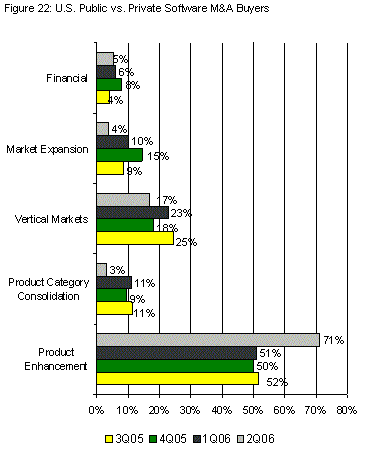|
|
| Home - Software M&A Review - Aug 06 Issue |
Software M&A - Q2 Review
continued... page 5 |
Finally, we analyzed median exit valuations in 1H06 based on the size (revenue) of the buyers and sellers, and concluded, once again, size has a material impact on purchase price. Buyers with revenue greater than $200 million are more likely to pay a significantly greater (possibly more than double) price than buyers with revenues below the $200 million threshold.
The moral of Figure 21 is for software industry buyers and sellers to be quite circumspect when applying the industry median exit valuation. Consider the following example: A private software company, looking at the median exit multiple for 1H06 might well estimate its selling price to be 2.7x TTM revenue. But according to Figure 21, a $17 million provider of customer relationship management solutions will likely fetch a very different offer from Oracle than Onyx, and a $14 million developer of digital publishing software can probably expect a markedly higher valuation from Adobe than Corel.
Mergers and Acquisitions: The Drivers
Product Extensions
Buyers in the second quarter sought to enhance their product suites by acquiring companies with complementary products and enabling technologies targeted at the same markets. Typically, these transactions, which we characterize as “product extensions”, are considered by the buyer to be highly strategic. We expect product extension deals will continue to dominate the software M&A landscape for the remainder of the year.
 Product extension deals accounted for 71% of the 135 Q2 software transactions we analyzed (Figure 22). Sellers whose offerings were deemed vital to improving the functionality or performance of the buyer’s suite commanded a 3.2x TTM revenue multiple in 2Q06. Representative product extension deals included Microsoft’s purchase of Whale Communications and iView to bolster its much anticipated Windows Vista offering, and Novell’s acquisition of eSecurity, a best-of-breed security management software provider to add a vital security component to its offering. Similarly, Sybase acquired Solonde, a provider of data integration technology known as ETL (Extract Transform Load), to enhance its offering in the highly competitive EAI market; and SAP, a methodical and calculated buyer, acquired Virsa Systems and Frictionless Commerce to flesh out its diverse application product stack. Product extension deals accounted for 71% of the 135 Q2 software transactions we analyzed (Figure 22). Sellers whose offerings were deemed vital to improving the functionality or performance of the buyer’s suite commanded a 3.2x TTM revenue multiple in 2Q06. Representative product extension deals included Microsoft’s purchase of Whale Communications and iView to bolster its much anticipated Windows Vista offering, and Novell’s acquisition of eSecurity, a best-of-breed security management software provider to add a vital security component to its offering. Similarly, Sybase acquired Solonde, a provider of data integration technology known as ETL (Extract Transform Load), to enhance its offering in the highly competitive EAI market; and SAP, a methodical and calculated buyer, acquired Virsa Systems and Frictionless Commerce to flesh out its diverse application product stack.
Market Expansion
In 2003, we noted a surprising number of buyers (20% in 4Q03) that ventured far from home to acquire software companies in entirely new product categories, new territories and new vertical markets in an effort to accelerate growth. The trend moderated in 2004 and 2005, with market expansion acquisitions comprising about 15% of all software M&A transactions. Market Expansion deals appear to be losing steam in 2006, accounting for 10% of software M&A deals in 1Q06, and only 4% of transactions in the second quarter. Representative market expansion transactions this quarter included: IBS AG, a Germany based provider of software solutions traditionally to the manufacturing vertical, acquired Discovery Travel Systems to gain exposure in the leisure and travel industry; Trimble Navigation, a navigation system and software provider, strengthened its position in the consumer packaged goods industry by acquiring Eleven; and ERP provider to discrete manufacturers, Intuitive Manufacturing Systems acquired Relevent Business Systems to further expand its presence within Aerospace and Defense.
Vertical Markets
Acquisitions by vertically focused buyers) accounted for a healthy 17% of all software M&A in 2Q06, down from a record 23% in 1Q06. While healthcare software company acquisitions have dominated this category in the past, M&A activity this quarter was strong across multiple vertical markets. Vertical market software deals in Q2 included transactions in education (Pearson/Chancery), financial services (Bloomberg/Brainpower), automotive retail (Reynolds & Reynolds/DCS), mining (Gencom/Surpax Minex) and, of course, healthcare (Cerner/Galt).
Product Category Consolidation
Consolidation (the acquisition of a software company by a typically larger industry player to gain market share and eliminate a competitor) which has remained relatively constant at nearly 11% over the last two years, represented only 3% of the software M&A deals in 2Q06. The two most notable deals within this category were Infor’s acquisition of SSA and JDA’s acquisition of Manugistics.
Investment Acquisitions
More than one in three software company buyers in 2Q06 were private. Most were venture-backed private software companies spending VC and private equity investor cash. However, in five percent of software M&A transactions in 2Q06 VCs and private equity firms, awash in cash and under growing pressure to invest it, acquired directly – opting primarily for large, established and relatively safe companies. The most notable deal within this category was Kohlberg Kravis Roberts acquisition of Flextronics’ software business, provider of software and services used to manage wireline, wireless and IP networks, for $900 million in cash.
Software Equity Group, L.L.C. (SEG), a mergers and acquisitions advisory firm serving the software, life science and technology sectors, prepared this report. SEG is solely responsible for its content. This material is based on data obtained from sources we deem to be reliable; it is not guaranteed as to its accuracy and does not purport to be complete. This information is not to be used as the primary basis of investment decisions. For more, please visit www.softwareequity.com, or phone (858) 509-2800.
 

|
|

